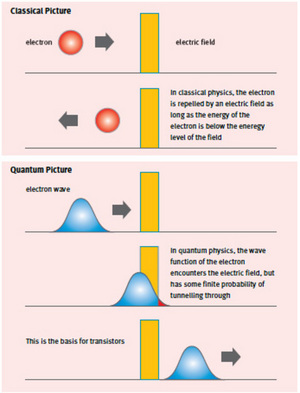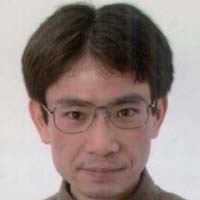Jun. 29, 2006 Research Highlight Engineering Physics / Astronomy
Transistor statistics add up
Better predictions of electron behavior could reduce the size of computer chips.
 Figure 1: Transistor statistics add up
Figure 1: Transistor statistics add up
Tiny transistors that allow current to flow just one electron at a time could ultimately help to build even smaller computer chips. So an improved mathematical model of how the electrons move should excite scientists trying to accurately predict the behavior of these devices.
Transistors work like taps for electricity, where a voltage at one terminal controls the flow of current between two others. Conventional transistors used in circuit boards can either be 'on' or 'off ', depending on whether current is flowing or not. These two states correspond to the 'ones' and 'zeros' that computers use to carry their binary information.
Single electron transistors (SETs) instead rely on just one electron dripping through the device to register a bit of information. Some SETs are made from individual molecules, and if they could be linked into a computing network it would significantly shrink the size of hardware inside electronic devices.
"I hope SETs have the potential to realise more powerful computers," says Yasuhiro Utsumi, a physicist at RIKEN's Discovery Research Institute in Wako, Japan. His new mathematical description of SETs, developed with Dmitri Golubev and Gerd Schon at the University of Karlsruhe, Germany, is a step in the right direction.
Tunnel to freedom
 Figure 2: Quantum tunnelling
Figure 2: Quantum tunnelling
SETs were first built in the late 1980s and rely on an effect called quantum tunnelling. Inside the SET, electrons are confined to a particular spot of metal by an insulating gap just a few billionths of a metre wide, which acts like the high walls of a prison. The electron does not have enough energy to climb this barrier, and yet because of the strange rules of the quantum world it still has a chance to reach the other side of the wall.
This is because the probability of finding an electron in a particular place can be expressed as its quantum wavefunction, which does not abruptly fall off to zero when it hits the wall. Instead, it trails off smoothly to leave a small probability of finding the electron on the other side of the insulating gap. This means that any imprisoned electrons will slowly but surely tunnel through the wall and reach the other side.
Heavier particles find it exponentially more difficult to tunnel in this way, which is why solid objects rarely drop straight through tables. But electrons are particularly good at this sort of escapology, so reliable theoretical models of their behavior, such as the Utsumi team's, are vital to predicting the behavior of devices relying on their individual properties.
Predicting the unpredictable
For electrons at the mercy of such quantum effects, fluctuations in their behavior can also decrease the predictability of a SET. Under certain conditions, electrons can pair up to escape from the transistor's core at the same time, and this 'co-tunnelling' can cause current leakage when the transistor is in its off state.
But the theoretical model of Utsumi's team can account for such quantum quirks, even when the device experiences the heavy traffic of electrons that is needed to maximise the working speed of the SET. Utsumi says he is particularly pleased that the model seems to work under these conditions, where previous theories have been less successful. In principle, we can find the optimum working conditions of a SET," he says.
The key to calculating the SET's current distribution is a mathematical method called full-counting statistics initiated by Levitov and Lesovik1. It aims to count the electrons one by one to obtain the statistical distribution of the electron current, from which one can analyse their properties," explains Utsumi.
This means that changes in the current through the transistor can be predicted for different conditions, and Utsumi hopes that other research groups will soon be able to measure these current profiles in working devices. The team describe their method in the journal Physical Review Letters2.
Super sensitivity
The mathematical method has also helped Utsumi to figure out how electrons move around in tiny fragments of material known as quantum dots, which can be made from less than a thousand atoms. In a paper posted to the arXiv preprint server3, Utsumi shows that full-counting statistics can predict how electrical currents in the dot relate to the number of electrons there, and also how the electrons move in and out of the dot. With a better theoretical understanding of how quantum dots work, scientists can better explore how to link them together into networks that could form the basis of more powerful computers.
Utsumi adds that the model could soon benefit researchers who are already making the most of SETs. In laboratories, SETs are actually used as ultra sensitive electrometers," he says. Electrometers can detect the movement of extremely small charges, but the noise generated by the current flowing through the SET itself limits their performance," explains Utsumi. So it is quite important to know the current distribution, from which one can get the noise properties."
References
- 1. Quantum Noise in Mesoscopic Physics, Vol. 97 of NATO Science Series II: Mathematics, Physics and Chemistry edited by Yu. V. Nazarov (Kluwer Academic Publishers, Dordrecht/Boston/London, 2003).
- 2. Utsumi, Y., Golubev, D. S. & Schon, G., Full counting statistics for a single-electron transistor: Nonequilibrium effects at Intermediate Conductance. Phys. Rev. Lett. 96, 086803 (2006). doi: 10.1103/PhysRevLett.96.086803
- 3. Utsumi, Y., Full counting statistics for number of electrons dwelling in a quantum dot. Phys. Rev. Lett. 96, 086803 (2006). doi: 10.1103/PhysRevLett.96.086803
About the Researcher

Yasuhiro Utsumi graduated from the Faculty of Engineering, Tohoku University in 1998, and earned his doctorate of information sciences at the same university in 2001. He served as a postdoc fellow at Max Planck Institute of Microstructure Physics in 2002-2004 and then at Institut fur Theoretische Festkorperphysik, Universitat Karlsruhe, both in Germany. In April 2005, Utsumi became a postdoc fellow at the Condensed Matter Theory Laboratory of RIKEN's Discovery Research Institute.
